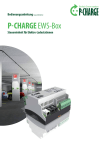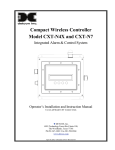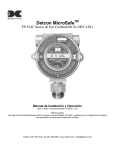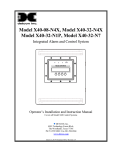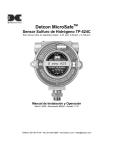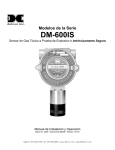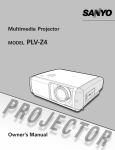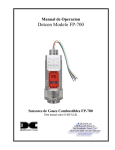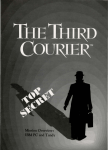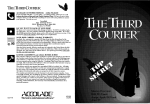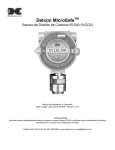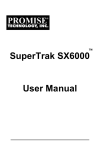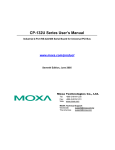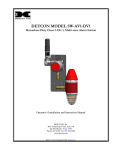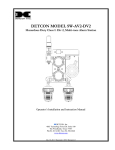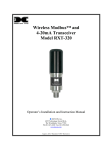Download Model CXT-IR
Transcript
Need Model CXT-IR Operator’s Installation and Instruction Manual Covers all Model CXT-IR Sensors DETCON, Inc. 4055 Technology Forest Blvd, The Woodlands, Texas 77381 Ph.281.367.4100 / Fax 281.298.2868 www.detcon.com September 30, 2013• Document 3822 • Revision 1.4 Model CXT-IR This page left intentionally blank Shipping Address: 4055 Technology Forest Blvd, The Woodlands Texas 77381 Mailing Address: P.O. Box 8067, The Woodlands Texas 77387-8067 Phone: 888.367.4286, 281.367.4100 • Fax: 281.292.2860 • www.detcon.com • [email protected] Model CXT-IR Rev. 1.4 ii Model CXT-IR Table of Contents 1. Introduction............................................................................................................................................1 1.1 Description ..................................................................................................................................................... 1 1.1.1 1.1.2 1.1.3 1.2 Non-Dispersive Infrared (NDIR) Optical Sensor Technology.................................................1 Principle of Operation .............................................................................................................2 Performance Characteristics ...................................................................................................2 Modular Design.............................................................................................................................................. 3 1.2.1 1.2.2 1.3 1.4 2. CXT-IR Intelligent Transmitter Module...................................................................................3 Field Replaceable Sensor ........................................................................................................4 CXT Wireless Network .................................................................................................................................. 5 Battery Pack Options...................................................................................................................................... 5 1.4.1 Detconꞌs Smart Battery Pack ................................................................................................... 5 1.4.2 Quad Battery Charger (Optional) ...........................................................................................6 1.4.3 Tri-C Lithium Battery Pack .....................................................................................................8 Installation..............................................................................................................................................8 2.1 2.2 Hazardous Locations Installation Guidelines for Safe Use ............................................................................ 8 Sensor Placement ........................................................................................................................................... 9 2.2.1 2.2.2 2.2.3 2.2.4 2.2.5 2.2.6 2.2.7 2.3 2.4 2.5 Density .....................................................................................................................................9 Leak Sources ..........................................................................................................................10 Ventilation..............................................................................................................................10 Personnel Exposure ...............................................................................................................10 Maintenance Access...............................................................................................................10 Placement of RF Antenna ......................................................................................................10 Additional Placement Considerations ...................................................................................10 Sensor Contaminants and Interference ......................................................................................................... 10 Sensor Mounting .......................................................................................................................................... 11 Electrical Installation.................................................................................................................................... 13 2.5.1 2.6 3. Applying Power to the Unit ...................................................................................................14 Initial Start Up .............................................................................................................................................. 15 2.6.1 Combustible Gas Sensors ......................................................................................................15 2.6.2 Initial Operational Tests........................................................................................................16 2.6.3 Material Requirements ..........................................................................................................16 Operation..............................................................................................................................................17 3.1 Operator Interface......................................................................................................................................... 18 3.1.1 3.1.2 3.1.3 3.1.4 3.2 3.3 Normal Operation..................................................................................................................18 Calibration Mode...................................................................................................................18 Program Mode.......................................................................................................................18 Software Flowchart................................................................................................................19 Normal Operation......................................................................................................................................... 20 Calibration Mode.......................................................................................................................................... 20 3.3.1 3.3.2 3.3.3 3.4 AutoZero ................................................................................................................................20 AutoSpan................................................................................................................................21 Material Requirements: .........................................................................................................21 Program Mode.............................................................................................................................................. 23 3.4.1 3.5 3.6 3.7 3.8 3.9 3.10 3.11 Navigating Program Mode ....................................................................................................23 View Sensor Status....................................................................................................................................... 24 Set Gas Type ................................................................................................................................................ 24 Set AutoSpan Level...................................................................................................................................... 25 Set Gas Factor .............................................................................................................................................. 25 Bump Test .................................................................................................................................................... 26 Restore Defaults ........................................................................................................................................... 27 Set RF Channel............................................................................................................................................. 27 Model CXT-IR Rev. 1.4 iii Model CXT-IR 3.11.1 3.12 4. Modbus™ TM Communications ........................................................................................................28 4.1 General Modbus™ Description .................................................................................................................... 28 4.1.1 4.1.2 4.2 5. Modbus™ Requests ...............................................................................................................29 Modbus™ Broadcast Requests ..............................................................................................29 Modbus™ Register Map and Directions ...................................................................................................... 30 4.2.1 CXT Sensor Registers ............................................................................................................32 4.2.2 CXT Transceiver Registers ....................................................................................................32 Service and Maintenance ....................................................................................................................34 5.1 5.2 5.3 5.4 Calibration Frequency .................................................................................................................................. 34 Visual Inspection .......................................................................................................................................... 35 Condensation Prevention Packet .................................................................................................................. 35 Replacement of the Batteries/Battery Pack................................................................................................... 35 5.4.1 5.4.2 5.4.3 5.5 5.6 5.7 6. Replacement of Plug-in Sensor..................................................................................................................... 36 Replacement of ITM – Aluminum Junction Box.......................................................................................... 37 Replacement of ITM – Stainless Steel Mini Condulet ................................................................................. 37 Missing Sensor Cell Fault............................................................................................................................. 39 Sensor Fault .................................................................................................................................................. 39 Under-Range problems ................................................................................................................................. 39 Stability problems......................................................................................................................................... 39 Clearing problem .......................................................................................................................................... 40 Poor Calibration Repeatability...................................................................................................................... 40 Unstable Output/ sudden spiking .................................................................................................................. 41 Nuisance Alarms........................................................................................................................................... 41 Transmitter not responding........................................................................................................................... 41 Low Battery / Low Voltage Fault ................................................................................................................. 42 Customer Support and Service Policy ...............................................................................................43 7.1 7.2 8. Low Battery Fault Indication.................................................................................................35 Units with 12V Smart Battery Pack .......................................................................................35 Units with Tri-C sized Lithium Battery Holder......................................................................35 Troubleshooting Guide........................................................................................................................38 6.1 6.2 6.3 6.4 6.5 6.6 6.7 6.8 6.9 6.10 7. Set Modbus™ ID....................................................................................................................27 Fault Diagnostic/Failsafe Feature ................................................................................................................. 28 Warranty Notice ........................................................................................................................................... 43 CXT-IR Sensor Warranty ............................................................................................................................. 44 7.2.1 Terms and Conditions............................................................................................................44 Appendix...............................................................................................................................................45 8.1 Specifications................................................................................................................................................ 45 8.1.1 8.1.2 8.1.3 8.1.4 8.2 8.3 System Specifications.............................................................................................................45 Environmental Specifications ................................................................................................45 Electrical Specifications ........................................................................................................45 Mechanical Specifications .....................................................................................................45 Spare Parts, Sensor Accessories, Calibration Equipment ............................................................................. 46 Revision Log................................................................................................................................................. 46 Model CXT-IR Rev. 1.4 iv Model CXT-IR Table of Figures Figure 1 Sensor Cell Construction...................................................................................................................2 Figure 2 Principle of Operation .......................................................................................................................2 Figure 3 Sensor Assembly Breakaway ............................................................................................................3 Figure 4 ITM Circuit Functional Block Diagram ............................................................................................4 Figure 5 Sensor Assembly Front View............................................................................................................4 Figure 6 Plug-in Sensor ...................................................................................................................................5 Figure 7 Smart Battery Pack............................................................................................................................6 Figure 8 Quad Battery Charger........................................................................................................................7 Figure 9 Tri C Size Lithium Battery Holder....................................................................................................8 Figure 10 Approval Label................................................................................................................................8 Figure 11 CXT-IR Sensor with Smart Battery Pack Mounting Dimensions.................................................12 Figure 12 CXT-IR Sensor with C-Cell Batteries...........................................................................................13 Figure 13 Terminal Interconnect for Smart Battery Pack..............................................................................15 Figure 14 Magnetic Programming Tool ........................................................................................................17 Figure 15 Magnetic Programming Switches .................................................................................................17 Figure 16 Software Flow Chart .....................................................................................................................19 Figure 17 Modbus™ Frame Format ..............................................................................................................28 Figure 18 Sensor Cell and ITM Mating.........................................................................................................36 List of Tables Table 1 Gas Factors .......................................................................................................................................26 Table 2 Exception Codes ...............................................................................................................................29 Table 3 CXT-IR Register Map ......................................................................................................................30 Table 4 Spare Parts, Sensor Accessories, and Calibration Equipment ..........................................................46 Table 5 Revision Log.....................................................................................................................................46 Model CXT-IR Rev. 1.4 v Model CXT-IR This page left intentionally blank Shipping Address: 4055 Technology Forest Blvd, The Woodlands Texas 77381 Mailing Address: P.O. Box 8067, The Woodlands Texas 77387-8067 Phone: 888.367.4286, 281.367.4100 • Fax: 281.292.2860 • www.detcon.com • [email protected] Model CXT-IR Rev. 1.4 vi Model CXT-IR 1. Introduction 1.1 Description Detcon Model CXT-IR combustible gas sensors are non-intrusive “Smart” sensors designed to detect and monitor combustible hydrocarbon gases in the air with a detection range of 0100% LEL (Lower Explosive Limit). The sensor features an LED display of current reading, fault and calibration status. A primary feature of the sensor is its method of automatic calibration, which guides the user through each step via fully scripted instructions illustrated on the LED display. The microprocessor-supervised electronics are enclosed in an encapsulated module and housed in an explosion proof casting. The unit includes; a built in 2.4GHz radio to transmit status wirelessly to a controller, 1.1.1 a four character alpha/numeric LED to display sensor readings, and a menu-driven interface when the hand-held programming magnet is in use. Non-Dispersive Infrared (NDIR) Optical Sensor Technology The sensor technology is designed as a miniature plug-in replaceable component, which can easily be changed out in the field. The NDIR sensor consists of (Figure 1); one infrared lamp source, two pyroelectric detectors (active and reference), and one optical gas sample chamber. The lamp source produces infrared radiation, which interacts with the target gas as it is reflected through the optical gas sample chamber. The infrared radiation contacts each of the two pyroelectric detectors at the completion of the optical path. The active pyroelectric detector is covered by a filter specific to the part of the IR spectrum where the target gas absorbs light. The reference pyroelectric detector is covered by a filter specific to the non-absorbing part of the IR spectrum. When the target gas is present, it absorbs IR radiation and the signal output from the active detective decreases accordingly. The reference detector output remains unchanged. The ratio of the active and reference detector outputs are then used to compute the target gas concentration. The technique is referred to as non-selective and may be used to monitor most any combustible hydrocarbon gas. Unlike catalytic bead type sensors, Detcon IR sensors are completely resistant to poisoning from corrosive gases and can operate in the absence of an oxygen background. The sensors are characteristically stable and capable of providing reliable performance for periods exceeding 5 years in most industrial environments. Model CXT-IR Instruction Manual Rev. 1.4 Page 1 of 46 Model CXT-IR Figure 1 Sensor Cell Construction 1.1.2 Principle of Operation The target gas diffuses through a sintered stainless steel flame arrestor and into the volume of the sample gas optical chamber. An alternating miniature lamp provides a cyclical IR radiation source, which reflects through the optical gas sample chamber and terminates at the two pyroelectric detectors. The active and reference pyroelectric detectors each give an output which measures the intensity of the radiation contacting their surface. The active detector is covered by an optical filter specific to the part of the IR spectrum where the target gas absorbs light. The reference detector is covered by a filter specific to the non-absorbing part of the IR spectrum. When present, the target gas absorbs a fraction of the IR radiation and the signal output from the active detector decreases accordingly. The signal output of the reference detector remains unchanged in the presence of the target gas. The ratio of the active/reference signal outputs is then used to compute the target gas concentration. By using the ratio of the active/reference signal outputs, measurement drift caused by the changes in the intensity of the IR lamp source or changes in the optical path’s reflectivity is prevented (Figure 2). Figure 2 Principle of Operation 1.1.3 Performance Characteristics The IR sensor maintains strong sensitivity to most all combustible hydrocarbon gases within the LEL range. When compared with the typical catalytic bead LEL sensor, the IR sensor exhibits improved longterm zero and span stability. Typical zero calibration intervals are quarterly to semi-annual and typical span intervals are semi-annual to annual. NOTE Actual field experience is always the best determination of appropriate calibration intervals. NOTE The CXT-IR sensor will not respond to combustible gases that are not hydrocarbons, such as H2, NH3, CO, H2S….etc. It can only be used to measure hydrocarbon type gases. The IR sensor generates different signal sensitivity levels for different combustible hydrocarbon target gases. Unless otherwise specified the CXT-IR sensor will be factory calibrated for methane service. If the Model CXT-IR Instruction Manual Rev. 1.4 Page 2 of 46 Model CXT-IR target hydrocarbon gas is other than methane, then the unit will have to be span calibrated and configured in accordance with this CXT-IR sensor instruction manual. 1.2 Modular Design The Model CXT-IR Sensor Assembly is completely modular and is made up of four parts (Error! Reference source not found.): 1) 2) 3) 4) CXT-IR Intelligent Transmitter Module (ITM) Plug-in infrared Sensor CXT Series Bottom Housing Splash Guard 100 Series Bottom Housing Assembly Splash Guard Ferrite Bead Magnetic Programming Switches 3 4" NPT Locking Nut Plug-in Replaceable Sensor Cell Intelligent Transmitter Module (ITM) Micro-processor controlled circuit encapsulated in an Explosion proof housing. Figure 3 Sensor Assembly Breakaway NOTE 1.2.1 All metal components are constructed from electro polished 316 Stainless Steel in order to maximize corrosion resistance in harsh environments. CXT-IR Intelligent Transmitter Module The Intelligent Transmitter Module (ITM) is a fully encapsulated microprocessor-based package that accepts a plug-in field replaceable combustible gas sensor. Circuit functions include (Figure 4); extensive I/O circuit protection, sensor pre-amplifier, on-board power supplies, microprocessor, LED display, magnetic programming switches, built-in 2.4GHz radio Model CXT-IR Instruction Manual Rev. 1.4 Page 3 of 46 Model CXT-IR Magnetic program switches located on either side of the LED Display are activated by a hand-held magnetic programming tool, allowing a non-intrusive operator interface with the ITM. The program switches allows calibration without declassifying the area. Intrinsically Safe Barrier Wireless MicroProcessor Plug-In Sensor Power supplies I/O Circuit Protection Accessory connections Antenna Power In Figure 4 ITM Circuit Functional Block Diagram detcon inc. LED Display detcon inc. MODEL Program Switch #1 CXT- IR PGM1 Program Switch #2 PGM2 ZERO SPAN H2S Sensor Housing Bottom Locking Set-Screw Figure 5 Sensor Assembly Front View 1.2.2 Field Replaceable Sensor Detconꞌs infrared gas sensors are field proven, plug-in sensors with over-sized gold-plated connections that eliminate corrosion problems. The sensor can be accessed and replaced in the field easily by releasing the locking screw and unthreading the splashguard adapter assembly. NOTE Detconꞌs combustible sensors have a long shelf life and are supported by an industryleading warranty. Model CXT-IR Instruction Manual Rev. 1.4 Page 4 of 46 Model CXT-IR Figure 6 Plug-in Sensor 1.3 CXT Wireless Network The CXT-IR sensor utilizes a transceiver radio, based on the IEEE 802.15.4 standard. The transceiver operates at 2.4 GHz using DSSS encoding for robustness in noisy conditions and to resist jamming. DSSS transmits data across a wider frequency range than the actual frequency range required for the information. This operation minimizes cross talk and interference from other transceivers and is less susceptible to noise from other sources. The IEEE 802.15.4 defines 16 separate RF Channels that can be used in the 2.4 GHz range. The default channel is 1 but can be changed if there is RF interference or if there is an existing network using that channel. Transceivers will only respond to other transceivers with the same RF Channel. NOTE If there are multiple CXT-IR networks in the same vicinity, each system must reside on a different RF Channel to keep data from one appearing on the other system. The 802.15.4 standard also implements a mesh network allowing any CXT-IR transceiver to relay or repeat data between adjacent neighbors. This makes the network very robust and provides the following immediate benefits. Allows re-routing of data in case of loss of a transceiver Allows re-routing around wireless obstacles Longer distances between transceivers because data can “hop” from one transceiver to the next Included in sensor, controller and alarm station transceivers CXT-IR transceivers can be deployed with less concern about physical location 1.4 Battery Pack Options The CXT-IR can be powered by a battery pack that enables the IR to be remotely mounted without the need for external cabling. Detcon offers several battery pack options that are factory installed. Contact Detcon for more information on these options. 1.4.1 Detconꞌs Smart Battery Pack The Detconꞌs plug-in Smart Battery Pack (Figure 7) provides an output of 12VDC. NOTE The CXT-IR monitors the battery life of the Smart Battery Pack. The battery pack consists of rechargeable Lithium-Ion batteries and is equipped with integrated safety electronics that include; Model CXT-IR Instruction Manual Rev. 1.4 Page 5 of 46 Model CXT-IR fuel gauge, voltage, current monitoring circuits, and temperature monitoring circuits. The Smart Battery Pack circuitry continuously monitors the battery's condition and reports critical status information to the wireless transceiver. The battery pack is designed to plug onto an 8-pin connector on a terminal board on the sensor. The battery pack and terminal board are housed in Detcon aluminum condulet for protection from exposure to outside elements and provide Class I Div 1, Group C, and D ratings. Operating periods before recharge will vary based on the sensor attached, but can be as long as six months and battery life can be up to five years before replacement is required. NOTE Improper use of the smart battery pack may be hazardous to personnel or the environment and will void the warranty. Figure 7 Smart Battery Pack 1.4.2 Quad Battery Charger (Optional) Detconꞌs Smart Battery Pack can be charged as needed using Detconꞌs optional Quad Battery Charger (Figure 8) which can charge up to four battery packs at one time. The Quad Battery Charger comes with a plug-in AC/DC adapter that uses a standard 100-240VAC outlet for power. The DC end of the adapter plugs into the DC power jack of the charger providing 24VDC. The Quad Battery Charger has four charging ports, each with 8-pin Beau connectors for battery pack connection. The ports and connectors are keyed to prevent incorrect positioning and connection. Each port has its own FAULT LED indicator and CHARGE LED indicator and will display either a red light or green light depending on the status of each battery being charged. Charging times will vary depending on the charge state of each battery pack, but a full charge of a depleted battery pack can take up to 24 hours. Model CXT-IR Instruction Manual Rev. 1.4 Page 6 of 46 Model CXT-IR Figure 8 Quad Battery Charger Model CXT-IR Instruction Manual Rev. 1.4 Page 7 of 46 Model CXT-IR 1.4.3 Tri-C Lithium Battery Pack The Tri-C Lithium Battery Pack (Figure 9) contains three 3.6V Lithium Primary C size batteries which are not re-chargeable. This battery pack offers a more compact size, and provides the unit with 10.8 volts. The batteries are contained in a battery holder mounted in Detconꞌs stainless steel explosion proof minicondulet. This option offers a smaller foot print, but provides less run time than Detcon’s Smart Battery Pack. The CXT-IR sensors will operate up to 60 days before battery replacement is needed. The addition of Detconꞌs Stainless Steel Mini Condulet provides Class I Div 1, Group B, C, and D ratings. Figure 9 Tri C Size Lithium Battery Holder 2. Installation 2.1 Hazardous Locations Installation Guidelines for Safe Use 1. Install the sensor only in areas with classifications matching the approval label. Follow all warnings listed on the label. Figure 10 Approval Label Model CXT-IR Instruction Manual Rev. 1.4 Page 8 of 46 Model CXT-IR 2. Do not remove the junction box cover while in the classified are unless it is conformed the there is no explosive gas levels in the area. 3. A good ground connection should be verified between the sensor’s metal enclosure and the junction box. If a good ground connection is not made, the sensor can be grounded to the junction box using the sensor’s external ground lug. Verify a good ground connection between the junction box and earth ground. 4. Proper precautions should be taken during installing and maintenance to avoid the build-up of static charge on the plastic components of the sensor (Splash Guard and Antenna Dome Cover) Wipe with damp cloth on plastic components to avoid static discharge. 5. Do not substitute components. Substitution of components may impair the intrinsic safety rating. 6. Do not operate the sensor outside of the stated operating temperature limits. 7. Do not operate the sensor outside the stated operating limits for voltage supply. 8. These sensors meet ATEX standards EN60079-0. EN60079-1 and EN60079-11. 9. These sensors have a maximum safe location voltage of UM=30V. 10. These sensors pass dielectric strength of 500VRMS between circuit and enclosure for a minimum of 1 minute at a maximum test current of 5mA. 11. The CXT-IR must only use combustible sensing cell model 371-IR1II1-000. WARNING: CSA certification does not include wireless communication or Modbus used for combustible gas performance.the wireless communication or Modbus may only be used for data collection or record keeping with regard to combustible gas detection. Gas indication and alarm fnctions for performance are only permitted locally by the detector. 2.2 Sensor Placement Selection of sensor location is critical to the overall safe performance of the product. Six factors play an important role in selection of sensor locations: Density of the gas to be detected Most probable leak sources within the industrial process Ventilation or prevailing wind conditions Personnel exposure Placement of transmitting antenna Maintenance access 2.2.1 Density Placement of sensors relative to the density of the target gas should be located within 4 feet of grade as heavy gases tend to settle in low lying areas. For gases lighter than air, sensor placement should be 4 to 8 feet above grade in open areas or in pitched areas of enclosed spaces. Model CXT-IR Instruction Manual Rev. 1.4 Page 9 of 46 Model CXT-IR 2.2.2 Leak Sources The most probable leak sources within an industrial process include flanges, valves, and tubing connections of the sealed type where seals may either fail or wear. Other leak sources are best determined by facility engineers with experience in similar processes. 2.2.3 Ventilation Normal ventilation or prevailing wind conditions can dictate efficient location of gas sensors in a manner where the migration of gas clouds is quickly detected. 2.2.4 Personnel Exposure The undetected migration of gas clouds should not be allowed to approach concentrated personnel areas such as control rooms, maintenance or warehouse buildings. A more general and applicable sensor location is combining leak source and perimeter protection in the best possible configuration. 2.2.5 Maintenance Access Consideration should be given to providing easy access for maintenance personnel and the consequences of close proximity to contaminants that may foul the sensor prematurely. NOTE 2.2.6 In all installations the gas sensor should point straight down (Figure 11). Improper sensor orientation may result in false readings and permanent sensor damage. Placement of RF Antenna Placement of the sensor should have consideration made for line of sight RF transmissions. The devices should be placed in a reasonable proximity to other devices in the network. Obstacles between CXT transceivers can impact RF line-of-sight and may result in communication problems. The CXT sensor should be in view of at least one other transceiver. 2.2.7 Additional Placement Considerations The sensor should not be positioned where it may be sprayed or coated with surface contaminating substances. Painting sensor assemblies is prohibited. Although the sensor is designed to be RFI resistant, it should not be mounted in close proximity to highpowered radio transmitters or similar RFI generating equipment. When possible mount in an area void of high wind, accumulating dust, rain, or splashing from hose spray, direct steam releases, and continuous vibration. If the sensor cannot be mounted away from these conditions then make sure the Detcon Harsh Location Dust Guard accessory is used. Do not mount in locations where temperatures will exceed the operating temperature limits of the sensor. Where direct sunlight leads to exceeding the high temperature-operating limit, use a sunshade to help reduce temperature. 2.3 Sensor Contaminants and Interference Detcon CXT-IR combustible hydrocarbon gas sensors may be adversely affected by exposure to certain airborne substances. Loss of sensitivity or corrosion may be gradual if such materials are present in sufficient concentrations. The performance of the IR sensor may be impaired during operation in the presence of substances that can cause corrosion on gold plating. Other inhibiting substances are those that can coat the internal walls of the optical chamber and reduce reflectivity. These include but are not limited to heavy oil deposits, Model CXT-IR Instruction Manual Rev. 1.4 Page 10 of 46 Model CXT-IR dust/powder, water condensation, and salt formation. Continuous and high concentrations of corrosive gases (such as Cl2, H2S, HCl …etc.) may also have a detrimental long-term effect on the sensorꞌs service life. The presence of such substances in an area does not preclude the use of this sensor technology, although it is likely that the sensor lifetime will be shorter as a result. Use of this sensor in these environments may require more frequent calibration checks to ensure safe system performance. For the CXT-IR combustible gas sensors there are no known cross-interference gases that are not combustible hydrocarbon gases. 2.4 Sensor Mounting The CXT-IR should be vertically oriented so that the sensor points straight downward (Figure 11). The explosion-proof enclosure or junction box is typically mounted on a wall or pole. Detcon provides a selection of standard junction boxes in both Aluminum and Stainless Steel. NOTE If wall mounting without a mounting plate, ensure to use at least 0.5"spacers under the Detcon Aluminum Junction Box’s 1/4" mounting holes to move the sensor assembly away from the wall and allow access clearance to the sensor assembly. Model CXT-IR Instruction Manual Rev. 1.4 Page 11 of 46 Model CXT-IR When mounting on a pole, secure the Junction Box to a suitable mounting plate and attach the mounting plate to the pole using U-Bolts. (Pole-Mounting brackets for Detcon Junction Boxes are available separately.) 8-32 tapped ground point Spacer 23" Typ. Use spacers to move sensor assembly away from wall at least 0.5". 4 NPT Port 4" mounting holes mounting surface) Spacer 3 1 Wall (or other 5.5" ITM Assembly Splash Guard Adapter Splash Guard 9.5" 7.45" Figure 11 CXT-IR Sensor with Smart Battery Pack Mounting Dimensions Model CXT-IR Instruction Manual Rev. 1.4 Page 12 of 46 Model CXT-IR 3.64" 4.1" 3 4 NPT Port 22"Typ. 3.45" Ø0.4 X 0.475" mounting holes Mini Condulet with Battery Holder and Batteries 6-32 tapped ground point ITM Assembly Splash Guard Adapter Splash Guard Figure 12 CXT-IR Sensor with C-Cell Batteries 2.5 Electrical Installation The CXT is designed to be battery operated, and normally will not have external cabling or wiring. If the sensor requires external wiring, the sensor assembly should be installed in accordance with local electrical codes. Proper electrical installation of the gas sensor is critical for conformance to electrical codes and to avoid damage due to water leakage. If a conduit run exists, a drain should be incorporated. The drain allows H2O condensation inside the conduit run to safely drain away from the sensor assembly. The electrical seal fitting is required to meet the National Electrical Code per NEC Article 500-3d (or Canadian Electrical Code Handbook Part 1 Section Model CXT-IR Instruction Manual Rev. 1.4 Page 13 of 46 Model CXT-IR 18-154). Requirements for locations of electrical seals are covered under NEC Article 501-5. Electrical seals also act as a secondary seal to prevent water from entering the wiring terminal enclosure. However, they are not designed to provide an absolute watertight seal, especially when used in the vertical orientation. NOTE A conduit seal is typically required to be located within 18" of the J-Box and Sensor Assembly. Crouse Hinds type EYS2, EYD2 or equivalent are suitable for this purpose. NOTE The Detcon Warranty does not cover water damage resulting from water leaking into the enclosure. NOTE Any unused ports should be blocked with suitable 3/4" male NPT plugs. Detcon supplies one 3 /4" NPT male plug with each J-box enclosure. If connections are other than 3/4" NPT, use an appropriate male plug of like construction material. If the Detcon CXT-IR was ordered with battery packs, no wiring is necessary. Although an external 24V source can be applied in some instances. If an external power source is incorporated, wire the external power source to the Terminal Interconnect board as prescribed in Figure 13. CAUTION 2.5.1 Do not apply System power to the sensor until all wiring is properly terminated (2.6 Initial Start Up). Applying Power to the Unit CAUTION A 24V solar panel is the most common option for supplying external power. A solar panel will recharge the Detcon Smart Battery Pack. It CANNOT be used with the C-cells. A 24V input with the C-cells will damage the cells. 1. Remove the junction box cover. 2. If external power is to be applied to the unit, connect incoming 24V to the terminal labeled "+" and 24V Return to the terminal labeled "-". 3. Install the batteries. NOTE The safety approvals require removing entire sensor assembly to a non-hazardous area before changing out the batteries or battery pack. a) For units utilizing the 12V Smart Battery Pack (Figure 13), plug the battery pack into the terminal board. If the sensor has a power switch, power will not be applied until the switch is turned on. If the unit does not have a power switch, power will be applied, and the unit will proceed to power up (Section 2.6). b) If the unit utilizes the C sized lithium 3.6V batteries and battery holder, install the batteries properly. If the sensor has a power switch, power will not be applied until the switch is turned on. If the unit does not have a power switch, power will be applied, and the unit will proceed to power up (Section2.6). Model CXT-IR Instruction Manual Rev. 1.4 Page 14 of 46 Model CXT-IR 4. Replace the junction box cover after Initial Start Up. 24VDC Return To External 24V Power - Red Black Wht/Blk Wht/Brn + To Sensor Figure 13 Terminal Interconnect for Smart Battery Pack NOTE A 6-32 or 8-32 threaded exterior ground point is provided on most junction boxes for an external ground. If the Sensor Assembly is not mechanically grounded, an external ground strap must be used to ensure that the sensor is electrically grounded. 2.6 Initial Start Up 2.6.1 Combustible Gas Sensors Upon completion of all mechanical mounting and installation of the batteries power is now applied to the unit. If the unit is equipped with the optional power switch, power is applied by pushing the switch. Observe the following normal conditions: 1. Upon power up, the sensor will scroll CXT-IR and will then display the current reading for approximately 5 seconds. A temporary upscale reading may occur as the sensor stabilizes. This upscale reading will decrease to 0% LEL within 1 to 2 minutes of power-up, assuming there is no gas in the area of the sensor. 2. After the initial power up, the sensor display will turn off. Thereafter the display will come on once every 10 seconds and will display the current reading for about 2 seconds, and will return to a blank display to conserve battery power. NOTE In normal operation the display will come on once every 10 seconds, will display the current reading for about 2 seconds, and will return to a blank display to conserve battery power. Model CXT-IR Instruction Manual Rev. 1.4 Page 15 of 46 Model CXT-IR 2.6.2 Initial Operational Tests After a warm up period of 1 hour (or when zero has stabilized), the sensor should be checked to verify sensitivity to the target gas. 2.6.3 Material Requirements Detcon Splash Guard with integral Cal Port and with Wind Guard (PN 613-120000-700) -OR- Detcon Threaded Calibration Adapter (PN 943-000006-132) -OR-Detcon Teflon Calibration Adapter for highly reactive gases (PN 943-01747-T05) Detcon Span Gas; 50% of range target gas in balance N2 or Air at fixed flow rate between 200500cc/min (500cc/min is preferred) NOTE Calibration gas generators using perm tubes or electrochemical sources may be used in place of span gas cylinders. 12. Attach the calibration adapter to the Splashguard Adapter Assembly or connect tubing to integral cal port. It is recommended that the Wind Guard (Detcon PN 943-000000-000) is installed over the Splash Guard during calibration. 13. Apply the test gas at a controlled flow rate of 200 - 500cc/min (500cc/min is the recommended flow). Observe that the ITM display increases to a level near that of the applied calibration gas value. NOTE Wind Guard must be used when calibrating with the integral cal port to ensure proper calibration. 14. Remove test gas and observe that the display decreases to 0. 15. If a calibration adapter was used during these tests, remove it from the unit, and re-install the Splash Guard. 16. If the wind guard was used, remove the wind guard. Initial operational tests are complete. CXT-IR Combustible gas sensors are factory calibrated prior to shipment, and should not require significant adjustment on start up. However, it is recommended that a complete calibration test and adjustment be performed 16 to 24 hours after power-up. Refer to calibration instructions in Section 3.3. Model CXT-IR Instruction Manual Rev. 1.4 Page 16 of 46 Model CXT-IR 3. Operation The Operator Interface of the Model CXT Series gas sensors is accomplished via two internal magnetic switches located to either side of the LED display (Figure 15). The two switches, labeled PGM1 and PGM2, allow for complete calibration and configuration, eliminating the need for area de-classification or the use of hot permits. Figure 14 Magnetic Programming Tool The magnetic programming tool (Figure 14) is used to operate the magnetic switches. Switch action is defined as momentary contact (a swipe), a 3 second hold, and a 10 second hold. (Hold times are defined as the time from the point when the arrow prompt appears. Swiping the magnet does not display the prompt.) For momentary contact use, the programming magnet is briefly held over a switch location, or swiped. For 3 second hold, the programming magnet is held in place over the switch location for three seconds. For 10 second hold, the programming magnet is held in place over the switch location for 10 seconds. The 3 and 10 second holds are generally used to enter calibration/program menus and save new data. The momentary contact is generally used to move between menu items and to modify set-point values. Arrows (◄ and ►) are used on the LED display to indicate when the magnetic switches are activated. The location of PGM1 and PGM2 are shown in Figure 15. detcon inc. Programming Switch #1 MODEL CXT-IR LED Display Programming Switch #2 Figure 15 Magnetic Programming Switches NOTE While in the program mode, if there is no magnetic switch interaction after 4 consecutive menu scrolls, the sensor will automatically revert to normal operating condition. While changing values inside menu items, if there is no magnet activity after 3 to 4 seconds the sensor will revert to the menu scroll. If the sensor is in Bump Test mode, the display will remain active. Model CXT-IR Instruction Manual Rev. 1.4 Page 17 of 46 Model CXT-IR 3.1 Operator Interface The operating interface is menu-driven by the two magnetic program switches located under the target marks of the sensor housing. The two switches are referred to as PGM1 and PGM2. The menu list consists of three menu items that include sub-menus; normal operation, calibration mode and, program mode. 3.1.1 Normal Operation Concentration Reading is displayed once every 10 seconds. 3.1.2 Calibration Mode AutoZero AutoSpan 3.1.3 Program Mode View Sensor Status Mp App ##.## CP App ##.## Rf App ##.##.## RfSw ##.## Modbus™ ID ## Serial Number ##.##.## RF Channel ## Network ID #### Sensor Sn ######## Range ### Autospan Level ## Last Cal ## Days Sensor Life ###% Temperature ##C Set Gas Type Set Autospan Level Set Gas Factor Bump Test Restore Defaults Set RF Channel Set Modbus™ ID Model CXT-IR Instruction Manual Rev. 1.4 Page 18 of 46 Model CXT-IR Instruction Manual Rev. 1.4 Temperature ##C Sensor Life ###% Last Cal ## Days Range ### Network ID ## RF Channel ## Serial N. ##.##.## Modbus ID #### RF SW ##.## RF App ##.##.## CP App ##.## MP App ##.## inc dec inc inc ## PGM2 (S) PGM1 (S) PGM1/2 (3) Set RF Channel AutoTime-out PGM1/2 (M) PGM1/2 (3) Type XX PGM2 (S) PGM1 (S) PGM1/2 (3) inc - Increase dec - Decrease #, ##, ### - numeric values (S) - Momentary Swipe (M) - Momentary hold of Magnet during text scroll until the ">" appears, then release (3) - 3 second hold from ">" prompt (10) - 10 second hold from ">" prompt Auto Time-out - 5 seconds PGM1 - Program Switch Location #1 PGM2 - Program Switch Location #2 LEGEND: Defaults Restored Restore Defaults Auto Time-Out PGM1/2 (M) PGM1/2 (3) ## PGM2 (S) PGM1 (S) PGM1/2 (3) Set Gas Type Auto Time-Out PGM1/2 (M) PGM1/2 (3) AutoTime-out PGM1/2 (M) PGM1/2 (3) AutoSpan AutoZero Set Autospan Level PGM1 (3) PGM2 (3) dec dec inc inc ## PGM2 (S) PGM1 (S) PGM1/2 (3) Set Modbus ID Auto Time-Out PGM1/2 (M) PGM1/2 (3) ## PGM2 (S) PGM1 (S) PGM1/2 (3) Set Gas Factor Auto Time-Out PGM1/2 (M) PGM1/2 (3) dec dec Bump Test 2 minute timeout Bump Test Started PGM1/2 (3) Auto Time-Out PGM1/2 (M) PGM1/2 (3) 3.1.4 View Sensor Status Auto Time-Out PGM1/2 (M) PGM1/2 (3) PGM1 (3) PGM2 (10) Normal Operation Model CXT-IR Software Flowchart Figure 16 Software Flow Chart Page 19 of 46 Model CXT-IR 3.2 Normal Operation In normal operation, the ITM Display will be blank and will display the gas reading once every 10 seconds for about 2 seconds (normally appear as 0). At any time swiping a magnet across either PGM1 or PGM2 will cause the ITM to display the units and gas type (i.e. % LEL or PPM H2S). If the sensor is actively experiencing any diagnostic faults, a swipe of the magnet will cause the display to scroll the fault condition. Refer to Section 3.12for more information on fault conditions. 3.3 Calibration Mode Zero and span calibration should be performed on a routine basis (quarterly minimum is advised) to ensure reliable performance. If a sensor has been exposed to any de-sensitizing gases, or to very high over-range combustible gas levels, re-calibration should be considered. Unless otherwise specified, span adjustment is recommended at 50% of the full scale range. To enter Calibration Mode hold the magnet over PGM1 for 3 seconds. If the sensor is experiencing a fault condition the "◄" prompt will not appear until the fault(s) have been displayed. When the ITM enters Calibration Mode the display will scroll Pgm1=Zero . . . Pgm2=Span twice before returning to Normal Mode (about 5 seconds). 3.3.1 AutoZero The AutoZero function is used to zero the sensor. AutoZero should be performed periodically or as required. AutoZero should be considered after periods of over-range target gas exposure. Local ambient air can be used to zero calibrate a combustible gas sensor as long as it can be confirmed that it contains no target or interference gasses. If this cannot be confirmed then a zero air or N2 cylinder should be used. Material Requirements: DetconMicroSafe™ Programming Magnet (PN 327-000000-000) Detcon Splash Guard with integral Cal Port and with Wind Guard (PN 613-120000-700) -ORDetcon Threaded Calibration Adapter (PN 943-000006-132) Detcon Zero Air cal gas (PN 942-001123-000) (or use ambient air if no target gas is present) Detcon Nitrogen 99.99% (PN 942-640023-100) NOTE The zero gas source may be zero air or N2 if local ambient air contains target or interference gases. a) For combustible gas sensors, if the ambient air is known to contain no target gas content, then it can be used for zero calibration. If a zero gas cal cylinder is going to be used, attach the calibration adapter and set flow rate of 200-500cc/min (500cc/min is the recommended flow rate) and let sensor purge for 1 to 2 minutes before executing the AutoZero. NOTE Wind Guard must be used when calibrating with the integral cal port to ensure proper calibration. b) From normal operation, enter calibration mode by holding the programming magnet over PGM1 for 3 seconds The display will then scroll Pgm1=Zero Pgm2=Span. Hold the programming magnet over PGM1 for 3 seconds once the "◄" prompt appears to execute AutoZero (or allow to timeout in 5 seconds if AutoZero is not desired). Model CXT-IR Instruction Manual Rev. 1.4 Page 20 of 46 Model CXT-IR NOTE The "◄" prompt will show that the magnetic switch is activated during the 3 second hold period. NOTE Upon entering calibration mode, the Modbus™ status register bit 14 is set to signify the sensor is in-calibration mode. This bit will remain set until the program returns to normal operation. c) The ITM will display the following sequence of text messages as it proceeds through the AutoZero sequence: Zero Cal . . . Setting Zero . . . Zero Saved (each will scroll twice) d) Remove the zero gas and calibration adapter, if applicable. 3.3.2 AutoSpan The AutoSpan function is used to span calibrate the sensor. AutoSpan should be performed periodically or as required. AutoSpan should be considered after periods of over-range target gas exposure. Unless otherwise specified, span adjustment is recommended at 50% of range. This function is called AUTO SPAN. NOTE 3.3.3 Before performing AutoSpan calibration, verify that the AutoSpan level matches the span calibration gas concentration as described in Section3.7 Set AutoSpan level. Material Requirements: DetconMicroSafe™ Programming Magnet (PN 327-000000-000) Detcon Splash Guard with integral Cal Port and with Wind Guard (PN 613-120000-700) -ORDetcon Threaded Calibration Adapter (PN 943-000006-132) Detcon Span Gas. Recommended span gas is 50% of range with target gas. Other suitable span gas sources containing the target gas in air or N2 balance are acceptable. NOTE Contact Detcon for ordering information on span gas cylinders. NOTE A target gas concentration of 50% of range is strongly recommended. This should be supplied at a controlled flow rate of 200 to 500cc/min, with 500cc/min being the recommended flow rate. Other concentrations can be used if they fall within allowable levels of 5% to 100% of range. NOTE It is generally not advised to use other gasses to cross-calibrate for span. Cross-calibration by use of other gasses should be confirmed by Detcon. CAUTION Verification that the calibration gas level setting matches the calibration span gas concentration is required before executing AutoSpan calibration. These two numbers must be equal. Model CXT-IR Instruction Manual Rev. 1.4 Page 21 of 46 Model CXT-IR AutoSpan consists of entering calibration mode and following the menu-displayed instructions. The display will ask for the application of span gas in a specific concentration. The applied gas concentration must be equal to the calibration gas level setting. The factory default setting and recommendation for span gas concentration is 50% of range. If a span gas containing the recommended concentration is not available, other concentrations may be used as long as they fall between 5% and 95% of range. However, any alternate span gas concentration value must be programmed via the Set AutoSpan Level menu before proceeding with AutoSpan calibration. Follow the instructions a) through f) below for AutoSpan calibration. a) Verify that the AutoSpan level is equal to the calibration span gas concentration. (Refer to View Sensor Status in Section 3.5.) If the AutoSpan level is not equal to the calibration span gas concentration, adjust the AutoSpan level as instructed in Section 3.3.2AutoSpan. b) From normal operation, enter calibration mode by holding the programming magnet over PGM1 for 3 seconds. NOTE The "◄"prompt will show that the magnetic switch is activated during the 3 second hold period. c) The display will then scroll PGM1=Zero PGM2=Span. Hold the programming magnet over PGM2 for 3 seconds to execute AutoSpan (or allow to timeout in 5 seconds if AutoSpan is not intended). The ITM will then scroll Apply XX % Gas. NOTE Upon entering calibration mode, the Modbus™ status register bit 14 is set to signify the sensor is in-calibration mode. This bit will remain set until the program returns to normal operation. d) Apply the span calibration test gas for combustible gas sensors at a flow rate of 200-500cc/min (500cc/min is the recommended flow rate). As the sensor signal begins to increase the display will switch to flashing XX reading as the ITM shows the sensorꞌs as found response to the span gas presented. If it fails to meet the minimum in-range signal change criteria within 2 minutes, the display will report Range Fault twice and the ITM will return to normal operation, aborting the AutoSpan sequence. The ITM will continue to report a Range Fault until a successful calibration is completed. NOTE Wind Guard must be used when calibrating with the integral cal port to ensure proper calibration. Assuming acceptable sensor signal change, after 1 minute the reading will auto-adjust to the programmed AutoSpan level. The ITM then reports the following messages: Remove Gas. e) Remove the span gas source and calibration adapter. The ITM will report a live reading as it clears toward 0. When the reading clears below 10% of range, the ITM will display Span Complete and will revert to normal operation. If the sensor fails to clear to less than 10% in less than 5 minutes, a Clearing Fault will be reported twice and the ITM will return to normal operation, aborting the AutoSpan sequence. The ITM will continue to report a Clearing Fault until a successful calibration is completed. f) AutoSpan calibration is complete. Model CXT-IR Instruction Manual Rev. 1.4 Page 22 of 46 Model CXT-IR NOTE If the sensor fails the minimum signal change criteria, a Range Fault will be declared and the Range Fault bit will be set on the Modbus™ output. NOTE If the sensor fails the clearing time criteria, a Clearing Fault will be declared and the Clearing fault bit will be set on the Modbus™ output. 3.4 Program Mode Program Mode provides a View Sensor Status menu to check operational and configuration parameters. Program Mode also provides for adjustment of the AutoSpan Level, Gas Factor, Gas Type and Range, and Serial ID. The Program Mode menu items appear in the order presented below: View Sensor Status Set Gas Type Set AutoSpan Level Set Gas Factor Bump Test Restore Defaults Set RF Channel Set Modbus™ ID 3.4.1 Navigating Program Mode From normal operation, enter program mode by holding the magnet over PGM2 for 10 seconds. NOTE The arrow prompt (◄ and ►) will show that the magnetic switch is activated during the 10 second hold period. The ITM will enter program mode and the display will scroll the first menu item View Sensor Status. To advance to the next menu item, hold the magnet over PGM1 or PGM2 while the current menu item text is scrolling. At the conclusion of the text scroll the arrow prompt for PGM2 or PGM1 will appear, and immediately remove the magnet. The ITM will advance to the next menu item. Repeat this process until the desired menu item is displayed. NOTE PGM1 moves the menu items from right to left and PGM2 moves the menu items from left to right. To enter a menu item, hold the magnet over PGM1 or PGM2 while the menu item is scrolling. At the conclusion of the text scroll the arrow prompt for PGM2 or PGM1 will appear, continue to hold the magnet over PGM1 or PGM2 for an additional 3 to 4 seconds to enter the selected menu item. If there is no magnet activity while the menu item text is scrolling (typically 4 repeated text scrolls), the ITM will automatically revert to normal operation. Model CXT-IR Instruction Manual Rev. 1.4 Page 23 of 46 Model CXT-IR 3.5 View Sensor Status View Sensor Status displays all current configuration and operational parameters including: sensor type, software version number, detection range, AutoSpan level, days since last AutoSpan, estimated remaining sensor life, gas factor, gas type, and sensor ambient temperature. From the View Sensor Status text scroll, hold the magnet over PGM1 or PGM2 until the arrow prompt appears and continue to hold the magnet in place for an additional 3 to 4 seconds (until the display starts to scroll Status Is). The display will scroll the complete list of sensor status parameters sequentially. When the status list sequence is complete, the ITM will revert to the View Sensor Status text scroll. The user can either: a) review list again by executing another 3 to 4 second hold, b) move to another menu item by executing a momentary hold over PGM1 or PGM2, or c) return to normal operation via automatic timeout of about 15 seconds (the display will scroll View Sensor Status four times and then return to normal operation). 3.6 Set Gas Type The IR sensor has a slightly different linearization requirement for different groupings of target gases. The two selections are; %LEL and %VOL. The Set Gas Type menu function is a simple choice between these two gas type groupings. NOTE The default value for Gas Type is methane (%LEL). The menu item appears as: Set Gas Type. From the Set Gas Type and Range text scroll, hold the magnet over PGM1 or PGM2 until the arrow prompt appears and continue to hold the magnet in place for an additional 3 to 4 seconds (until the display starts to scroll %LEL / %VOL). Swipe the magnet momentarily over PGM2 or PGM1 to change the selection until the correct choice is displayed. Hold the magnet over PGM1 or PGM2 for 3 seconds to Model CXT-IR Instruction Manual Rev. 1.4 Page 24 of 46 Model CXT-IR accept the new value. The display will scroll Type Saved, then Set Range followed by the currently selected Range. Momentarily hold the magnet over PGM1 or PGM2 to change the Range Selection until the correct value is displayed. Hold the magnet over PGM2 for 3 seconds to accept the new value. Move to another menu item by executing a momentary hold, or, return to normal operation via automatic timeout of about 15 seconds (the display will scroll Set Gas Type 4 times and then return to normal operation). 3.7 Set AutoSpan Level Set AutoSpan Level is used to set the span gas concentration level that is being used to calibrate the sensor. This level is adjustable from 5% to 95% of range. The current setting can be viewed in View Program Status. The menu item appears as: Set AutoSpan Level. From the Set AutoSpan Level text scroll, hold the magnet over PGM1 or PGM2 until the arrow prompt appears and continue to hold the magnet in place for an additional 3-4 seconds (until the display starts to scroll Set Level). The display will switch to XX (where XX is the current gas level). Swipe the magnet momentarily over PGM2 to increase or PGM1 to decrease the AutoSpan Level until the correct level is displayed. When the correct level is achieved, hold the magnet over PGM2 for 3 to 4 seconds to accept the new value. The display will scroll Level Saved, and revert to Set AutoSpan Level text scroll. Move to another menu item by executing a momentary hold, or return to normal operation via automatic timeout of about 15 seconds (the display will scroll Set AutoSpan Level 4 times and then return to normal operation). 3.8 Set Gas Factor Because of the CXT-IR sensorꞌs almost universal response to combustible hydrocarbon gases, the CXT-IR sensor can be configured and calibrated to detect a variety of combustible gases. The detected gas is referred to as the "target gas" and the span calibration gas is referred to as the "cal gas". In cases where the cal gas is different from the target gas, the Set Gas Factor menu function is used to maintain accuracy. This feature allows for a significant degree of flexibility in the detection and span calibration process. NOTE The default value for Gas Factor is 1.0. This would be used when the target gas is the same as the cal gas. Set Gas Factor is used to make the appropriate signal sensitivity adjustment when the target gas is different from the cal gas. This is necessary because the IR sensor has different signal strengths for each combustible hydrocarbon gas. The Gas Factor value is adjustable from 0.2 to 5.0. It represents the translation between the target gas and the cal gas when they are different. The menu item appears as: Set Gas Factor. To calculate the correct Gas Factor (Table 1), take the Gas Factor of the target gas and divide by the Gas Factor of the cal gas. The calculated value is the correct number to enter into the menu as the Gas Factor. For example, if calibrating with methane when propane is the target gas, the correct Gas Factor to enter would be 0.63/1.0 = 0.63. Model CXT-IR Instruction Manual Rev. 1.4 Page 25 of 46 Model CXT-IR For example, if calibrating with butane when ethane is the target gas, the correct Gas Factor to enter would be 0.38/0.72=0.53. Table 1 shows the Gas Factors of most combustible hydrocarbon gases that will be measured. Find the gas of interest for the cal gas and the target gas and follow the above instruction. If there is a mixture of target gases, use a weighted approach to determine the correct Gas Factor. For example, if the target gas was 50% butane and 50% pentane and the cal gas was methane, the correct Gas Factor would be calculated and entered as ((0.5 x 0.77) + (0.5 x 0.77)) / 1.0 = 0.77. Table 1 Gas Factors Gas Acetic Acid Acetone Benzene 1,3-Butadiene Butane Iso-Butane Butene-1 n-Butyl Alcohol iso-Butyl Alcohol Cyclohexane Cyclopropane Factor 2.00 1.21 1.00 1.80 0.77 0.72 0.67 0.63 0.63 0.89 0.45 Gas Factor Decane Ethyl Alcohol Ethane Ethyl Benzene Ethylene n-Heptane n-Hexane Dimethyl Ether Methane Methanol Methyl Ethyl Ketone 1.53 0.35 0.38 1.07 2.39 0.98 1.00 0.40 1.00 0.41 0.77 Gas Naphthalene n-Nonane n-Octane n-Pentane Propane iso-Propyl Alcohol Propylene Toluene Vinyl Acetate Vinyl Chloride Xylene Factor 1.53 1.34 0.77 0.63 0.54 0.80 1.00 1.43 1.00 From the Set Gas Factor text scroll, hold the magnet over PGM1 or PGM2 until the arrow prompt appears and continue to hold the magnet in place for an additional 3 to 4 seconds (until the display starts to scroll Set Factor). The display will then switch to X.XX (where X.XX is the current gas factor). Swipe the magnet momentarily over PGM2 to increase or PGM1 to decrease the gas factor level until the correct value is displayed. Hold the magnet over PGM2 for 3 seconds to accept the new value. The display will scroll Factor Saved, and revert to Set Gas Factor text scroll. Move to another menu item by executing a momentary hold, or, return to normal operation via automatic timeout of about 15 seconds (the display will scroll Set Gas Factor four times and then return to normal operation). 3.9 Bump Test Bump Test is used to check the response of the sensor with the indication of response limited to the display only. The results of the bump test will not affect the reading register on the Modbus™ output. The menu item appears as: Bump Test From the Bump Test text scroll, hold the magnet over PGM1 or PGM2 until the arrow prompt appears and continue to hold the magnet in place for an additional 3 to 4 seconds (until the display starts to scroll Bump Test Started). The display will return to normal operation alternating between the live gas reading and showing Bump until 2 minutes expires or the execution of a momentary hold over PGM1 or PGM2, when the display will scroll Bump Test Ended. Model CXT-IR Instruction Manual Rev. 1.4 Page 26 of 46 Model CXT-IR 3.10 Restore Defaults The CXT-IR sensor has the option to restore its internal memory settings to factory default conditions. The menu item appears as: Restore Defaults. From the Restore Defaults text scroll, hold the magnet over PGM2 until the arrow prompt appears and continue to hold the magnet in place for an additional 3 to 4 seconds (until the display starts to scroll Defaults Restored). The display will then revert to Restore Defaults text scroll. Move to another menu item by executing a momentary hold, or, return to normal operation via automatic timeout of about 15 seconds (the display will scroll Restore Defaults four times and then return to normal operation). CAUTION After the defaults are restored, the sensor must be recalibrated. 3.11 Set RF Channel The CXT-IR sensor communicates wirelessly and can be set to use unique wireless radio channel. Set RF Channel is used to set the RF radio channel. It is adjustable from 0 to 15. The menu item appears as: Set RF Channel. From the Set RF Channel text scroll, hold the programming magnet over PGM1 or PGM2 until the arrow prompt appears and continue to hold the magnet in place for an additional 3 to 4 seconds (until the display starts to scroll Set Channel). The display will then switch to XX (where XX is the current RF channel). Swipe the magnet momentarily over PGM2 to increase or PGM1 to decrease the hexadecimal number until the desired ID is displayed. Hold the magnet over PGM2 for 3 to 4 seconds to accept the new value. The display will scroll Channel Saved, and revert to Set RF Channel text scroll. Move to another menu item by executing a momentary hold, or, return to Normal Operation via automatic timeout of about 15 seconds (the display will scroll Set RF Channel four times and then return to Normal Operation). 3.11.1 Set Modbus™ ID The CXT-IR sensor can be polled serially via RS-485 Modbus™ RTU. Set Modbus™ ID is used to set the Modbus™ serial ID address. It is adjustable from 01 to 256 in hexadecimal format (01-FF) hex. The menu item appears as: Set Modbus™ ID. From the Set Modbus™ ID text scroll, hold the programming magnet over PGM1 or PGM2 until the arrow prompt appears and continue to hold the magnet in place for an additional 3 to 4 seconds (until the display starts to scroll Set ID). The display will then switch to XX (where XX is the current ID address). Swipe the magnet momentarily over PGM2 to increase or PGM1 to decrease the hexadecimal number until the desired ID is displayed. Hold the magnet over PGM2 for 3 to 4 seconds to accept the new value. The display will scroll ID Saved, and revert to Set Modbus™ ID text scroll. Model CXT-IR Instruction Manual Rev. 1.4 Page 27 of 46 Model CXT-IR Move to another menu item by executing a momentary hold, or, return to normal operation via automatic timeout of about 15 seconds (the display will scroll Set Modbus™ ID four times and then return to normal operation). 3.12 Fault Diagnostic/Failsafe Feature If the ITM should incur a fault, the Global Fault bit will be set on the Modbus™ output. This can occur if the ITM detects a problem with the sensor, detects that there is no sensor connected, if the ITM has an internal fault, or other fault condition. The Global Fault bit will be set on the Modbus™ output until the problem is resolved. The display will show the Fault when a magnetic programming tool is swiped across either PGM1 or PGM2. The error codes are defined in Section 6Troubleshooting. 4. Modbus™ TM Communications Modbus™ communication with a CXT Sensor is normally accomplished using another wireless transceiver such as the RXT-320 which is connected through a RS-485 interface to a Modbus™ master control unit. The control unit can then access the Modbus™ registers within the CXT to obtain readings and status of the sensor. As with normal Modbus™ operation, there can be only one Modbus™ master that polls all the other devices on the network which are considered Modbus™ slaves. Each sensor must have a unique Modbus™ address and be on the same RF channel (for communication) to work properly on the wireless network. Both the Modbus™ ID and the RF channel are set on the CXT sensor using the display. The Modbus™ master control unit with RXT-320 transceiver (or equivalent) is responsible for broadcasting requests and receiving slave device responses. The CXT sensor receives these requests through its own internal transceiver and responds if the Modbus™ address and proper register set matches. The response will be received by the RXT-320 and presented to the master control unit across the RS-485 interface. 4.1 General Modbus™ Description The Modbus™ communication uses the RTU transmission mode per the Modbus™ specification. The basic frame format for Modbus™ consists of a Modbus™ address, function code, data and CRC. Address Field Function Code Data CRC Figure 17 Modbus™ Frame Format The Modbus™ ID Field is the unique Modbus™ address of each device on the network. The Function Code is the function to be performed. The Data contains read or write data and is formatted according to the function being performed. The CRC (Cyclic Redundancy Code) is used to detect errors in the frame. Frames with errors are invalid and ignored. Model CXT-IR Instruction Manual Rev. 1.4 Page 28 of 46 Model CXT-IR Modbus™ transactions consist of both a request by the controller and response from the device being addressed so there are two frames transferred for every transaction. Every request is evaluated by the CXT to determine if it is addressed to it, and if it falls within the register address range. If these two conditions are true, the CXT will then check to see if it is a valid Function Code. Function Codes supported by the CXT are: Function Code 03 (03h) – Read Holding Registers Function Code 06 (06h) – Write Single Register Function Code 16 (10h) – Write Multiple Registers If an invalid function code is performed, the CXT will ignore the request by default and the controller will timeout and continue with the next transaction. 4.1.1 Modbus™ Requests The CXT is capable of returning Modbus™ exceptions when it cannot service a Modbus™ request meant for that CXT. By default this is turned off since it can cause issues with some controllers that do not process Modbus™ exceptions. (Section 4.2.2.4 Register – Control) The following exception codes are supported and returned when Modbus™ exceptions are enabled: Table 2 Exception Codes Exception Code Name Meaning 01 Illegal Function Unsupported function code. Only 03, 06 and 16 are supported. 02 Illegal Data Address Invalid register address detected. If any request for registers outside of the valid register address for the CXT occurs, this exception code will be returned. There are other exception codes defined in Modbus™ but these are the only ones used by the CXT. NOTE 4.1.2 When using Detcon controllers, Modbus™ exceptions should be turned off. Modbus™ Broadcast Requests The Modbus™ broadcast request was introduced in the CXT to support commands to be executed across all CXT transceivers simultaneously. This is used to place all CXTs in a low power state for a specified time to conserve battery life. Only the transceivers (radio) are placed into a low power state, the CXT sensor will continue to operate normally. If none of the CXTs are battery powered then there is no need to issue a command to place the transceivers in low power mode. According to the Modbus™ specification a broadcast request is defined as a request with the Address Field set to 0 and is used only for writing. There is no response returned as with normal Modbus™ transactions since all devices on the system are accessed at the same time. Both Function Codes 06 and 16 (writes) are supported with a broadcast request on the CXT. Model CXT-IR Instruction Manual Rev. 1.4 Page 29 of 46 Model CXT-IR Since there is no response on the broadcast request, there is a requirement to wait for a period of time before sending out the next request. This allows all slave devices to process the command before the next request is received, also known as the turnaround delay. This turnaround delay should be approximately 150 milliseconds for broadcast requests sent to the CXT. Controllers in general can meet this timing because it takes longer than this to generate the next request so it may be unnecessary to make any adjustments. Controllers that generate Modbus™ broadcast requests to the CXT must ensure a turnaround delay of 150ms is met otherwise the next request can cause the broadcast request to be overwritten and ignored. NOTE Broadcast requests are not confined to commands to put the network in low power mode, but can be used where any normal write command is used. 4.2 Modbus™ Register Map and Directions When the CXT is assigned a Modbus™ address, the following registers become available to the controller for access. All CXT sensors implement this register set. Some registers are Read Only (R) and others are Read/Write (R/W) as shown by the R/W column. This equates to specific function codes where Read is function code 03 and Write is function code 06 or 16. A write to a Read Only register is allowed and returns a response, but it does not change the value of the register. In some devices this would return an exception code. NOTE The register map (Table 3) for the CXT sensor gives a brief description for each register or register set. This information is only meant as a reference. The registers are divided into two sections, one for the CXT sensor and the other for the CXT transceiver. For a more detailed description of the Register Map please contact Detcon. Table 3 CXT-IR Register Map Offset Name R/W 0000 CXT-IR-100 Device Type 0001 Range 0002 Reading 0003 Calibration Level 0004 Life R Sensor Life 0005 Sensor Faults R Fault bits 0006 Sensor Model R IR (set to 3) 0007 Days since Calibration R 0008 Reserved R 0009 Reserved R 0010 Sensor Temperature R 0011 Gas Factor R 0012 Reserved R 0013 Reserved R 0014 Range divisor 0015 CONTROL 0016 String String 0017 Model CXT-IR Instruction Manual R Description R/W R R/W = 36 Detectable Range Current Gas Reading Auto Span Level R R/W R Set during production/test R Set during production/test Rev. 1.4 Page 30 of 46 Model CXT-IR Offset Name R/W Description 0018 String R Set during production/test 0019 String R Set during production/test 0020 String R Set during production/test 0021 String R Set during production/test 0022 Reserved R/W NOT USED 0023 Sensor Controller Version R Year.Week 0024 Reserved R 0025 Reserved R 0026 Reserved R 0027 Wireless Controller Version R 0028 Reserved R 0029 Radio Firmware Version R 00.Major 0030 Radio Firmware Version R Minor.Build 0031 Radio Software Version R Major.Minor 0032 Wireless ID High R 00.XX 0033 Wireless ID Low R XX.XX 0034 RF Channel R Wireless RF Channel (Set in Display) 0035 Network ID R Defaults to RF Channel (Set in Display) 0036 Modbus™ Address R CXT Modbus™ Address (Set in Display) Major.Minor RXT-320 Compatible Registers for Wireless Transceiver 8192 RXT-320 Device Type R 8193 Reserved -- 8194 Reserved -- 8195 Reserved -- 8196 Reserved -- 8197 Reserved -- 8198 Reserved -- 8199 Battery Life in Percent R Smart Battery Life remaining in percent 8200 Battery Life in Minute R Smart Battery Life remaining in minutes 8201 Wireless Controller Version R same as register 0027 8202 RF Update Rate W 8203 Control R/W Wireless Control 8204 Status R Wireless Status 8205 Input Voltage R Smart Battery voltage or Input Voltage to A/D 8206 Battery Error Count 8207 Reserved -- 8208 Timestamp[0] R Time since power applied -- Seconds High 8209 Timestamp[1] R Time since power applied -- Seconds Low 8210 Timestamp[2] R Time since power applied -- Milliseconds Model CXT-IR Instruction Manual R/W Rev. 1.4 22 (for compatibility) Number of seconds to power down transceiver Smart Battery read error count if detected Page 31 of 46 Model CXT-IR 4.2.1 CXT Sensor Registers 4.2.1.1 Sensor Faults – Register 0005 The sensor fault status register consists of High and Low Status Bits. These bits are set/reset as faults occur or are cleared. Each bit has a particular meaning: Register # 0005 High Byte Status Bits Low Byte Status Bits Bits read as 0 are FALSE; bits read as 1 are TRUE Status Bits High Byte Bit 15 – Reserved Bit 14 – Calibration Mode Bit 13 – Reserved Bit 12 – Zero Fault Bit 11 – Range Fault Bit 10 – Reserved Bit 9 – Clearing Fault Bit 8 – Reserved Status Bits Low Byte Bit 7 – Sensor Fault Bit 6 – Processor Fault Bit 5 – Memory Fault Bit 4 – Reserved Bit 3 – Reserved Bit 2 – Temperature Fault Bit 1 – Auto Span Fault Bit 0 – Global Fault 4.2.2 CXT Transceiver Registers 4.2.2.1 Battery Info – Multiple Registers When a Detcon smart battery pack is connected to the CXT, there are five registers associated with information about that battery. The CXT utilizes the I2C interface to read battery status and only one Detcon battery pack can be read per CXT. The controller can determine the presence of a battery by reading the Status Register (register 8204). There are two bits in this sixteen bit register pertaining to the battery; Battery Detect – bit 4 (lowest bit is 0) and Battery Fault – bit 5. Both bits default to a value of 0. Battery Detect will be set once the first read of the battery over the I2C interface was successful. Battery Fault will be set if a battery was detected but the last read failed. Battery Fault is re-evaluated upon every read of the battery which is set to approximately every 5 seconds. Register Model CXT-IR Instruction Manual Rev. 1.4 Page 32 of 46 Model CXT-IR 8206 (I2C Batt Read Fails) will increment by four each time there is a failure since there are four attempts before declaring failure. This register can be cleared by writing a 0 to it at any point. Once the battery has been detected the controller can read the battery life (registers 8199 and 8200). The battery adjusts these values based upon the average current usage. If usage varies widely over time it will take some time to re-adjust the battery life readings. For example, an alarm station with no alarms will consume a very small amount of battery but when alarms are active this will jump to a much higher level of usage. So in this case battery life may go from several weeks down to several hours. The battery life is presented in two forms, life remaining in percentage (register 8199) and life remaining in minutes (register 8200). The battery life remaining (%) is a value between 0 and 100 and battery life in minutes is an unsigned value between 0 and 65535. Both readings are generally necessary to provide appropriate feedback to the user. Life in minutes is the best for determining when to change the battery. For example, to be notified a day before the battery needs to be changed, set a threshold in the controller to be notified of low battery after 1440 minutes (1 day). The maximum value for life remaining in minutes is 65535 (45.5 days). The battery life for an application can be much greater than the maximum value and the reading will remain at 65535 until it drops below the maximum value. Life in percentage provides a more efficient tracking method. Percentage will track starting at 100% and drop down as the battery life decreases. The controller can therefore use both registers, one to represent usage in percentage to present to the user and then use the life in minutes to set a threshold on when a low battery condition exists for changing the battery. 4.2.2.2 Wireless Controller Version This is set to a value based upon the version of firmware programmed into the RXT-320 microcontroller. It is stored as two byte value representing the major and minor revision numbers. So a 0113h (275 decimal) represents a major version of 01 and minor version of 13. As software is updated this will be incremented appropriately. 4.2.2.3 Register – Update Rate The update rate represents the amount of time in seconds the CXT transceiver will be in a low power state. Its main purpose is to provide a mechanism to place all wireless transceivers in a system into a low power mode to conserve battery power. If there are no batteries used within the network of wireless transceivers this register would not be utilized. Upon power up, this register is set to 0 and the CXT transceiver is not in low power mode. To place a network to low power mode the controller will generate a broadcast request (Modbus™ address = 0) and do a single write (function code 06) to register 8202 with the number of seconds the network should go into low power mode. During low power mode, there can be no access to any device on the network so changes in sensor readings will not be updated. Once a non-zero value is written to this register on all transceivers, they will begin counting down until the Update Rate register reaches zero, at which time all transceivers should be active again and ready for network communication. The controller will monitor the update rate time remaining by accessing Update Rate register on the RXT-320 (or equivalent) that it is attached. The Modbus™ interface remains active, only the wireless network is placed in a low power state. The value of this register can be between 0 and 65535 which allows a maximum low power time of 18.2 hours. Removal of power will reset Update Rate to 0 and the transceiver will be active again. Model CXT-IR Instruction Manual Rev. 1.4 Page 33 of 46 Model CXT-IR 4.2.2.4 Register – Control The CXT transceiver control register is generally unused and should not be written to normally. Using the control register, the CXT can be reset and Modbus™ exceptions can be enabled. Each bit in the control register can control a particular function and should be read first then modify the bits needed and written back. The default state of the register is 0. All reserved bits should always be set to a 0 when writing. The bit assignments are: Bit 15: Bit 14: Bit 13 – 12: Bit 11: Bit 10 – 08: Bit 07: Bit 06: Bit 05 – 00: Reserved (set to 0) Reserved (set to 0) Reserved (set to 0) Modbus™ Exceptions Enabled Reserved (set to 0) Reset the microcontroller and wireless radio Reset the microcontroller Reserved (set to 0) 4.2.2.5 Register – Status This register contains status of the CXT transceiver and some of the bits have already been covered in the battery description. These default to 0 upon reset. The bit assignment and description are given below. Bit 15 – 08: Bit 07: Bit 06: Bit 05: Bit 04: Bit 03: Bit 02: Bit 01: Bit 00: Reserved (set to 0) Reserved (set to 0) Reserved (set to 1) I2C Fault on last read of Battery Status Battery Detected Reserved (set to 0) Reserved (set to 1) Reserved (set to 0) Reserved (set to 0) 4.2.2.6 Register – Timestamp Three registers are utilized to maintain a timestamp that increments on the microcontroller after power up. These are all set to 0 upon power up or a microcontroller reset. The first two registers 8208 and 8209 are internally combined into a single 32 bit register and incremented each second. The last register 8210 maintains the millisecond count and will count from 0 to 999 and start over again. 5. Service and Maintenance 5.1 Calibration Frequency In most applications, monthly to quarterly span calibration intervals will assure reliable detection. Upon initial installation and commissioning, close frequency tests should be performed, weekly to monthly. Test results should be recorded and reviewed to determine a suitable calibration interval due to differences in industrial environments. Model CXT-IR Instruction Manual Rev. 1.4 Page 34 of 46 Model CXT-IR 5.2 Visual Inspection The Sensor should be inspected annually for the following: Inspect the sensor for signs of corrosion, pitting, and water damage. Remove the Splash Guard and inspected it for blockage, broken, cracked, or missing pieces. For H2S Sensor assemblies, inspect CXT-IR Series Splashguard Adapter Assembly with integral filter (PN 602-003552-100) for blockage of filter material. Inspect inside of the Junction Box for signs of water accumulation, signs of corrosion. Check wiring to ensure there are no loose or pinched wires and all connections are clean and tight. 5.3 Condensation Prevention Packet A moisture condensation packet (Detcon PN 960-202200-000) should be installed in every explosion proof Junction Box. The moisture condensation prevention packet will prevent the internal volume of the J-Box from condensing and accumulating moisture due to day-night humidity changes. This packet provides a critical function and should be replaced annually. 5.4 Replacement of the Batteries/Battery Pack 5.4.1 Low Battery Fault Indication The CXT-IR Sensor incorporates a ‘Low battery’ fault message which will appear as an alternating display between the current gas reading and ‘VOLT’ on the sensor display. This fault will appear when the battery voltage drops below 7.5 volts. When the voltages drops below 7.2 volts the display will change to a steady ‘VOLT’ display, the sensor will then enter into ‘Fault’ mode, and the sensor will no longer provide a valid gas reading. 5.4.2 NOTE Units with 12V Smart Battery Pack The safety approvals require removing entire sensor assembly to a non-hazardous area before changing out the batteries or battery pack. 1. Remove the cover from the J-box. 2. Unlatch the holding lever on the side of the battery bracket, and swing the cover away from the battery pack. 3. Remove the battery pack from the J-box, and replace with new battery pack. 4. Swing the cover back over the battery pack, and ensure that it is latched. 5. Replace the cover on the J-box. 5.4.3 NOTE Units with Tri-C sized Lithium Battery Holder The safety approvals require removing entire sensor assembly to a non-hazardous area before changing out the batteries or battery pack. Model CXT-IR Instruction Manual Rev. 1.4 Page 35 of 46 Model CXT-IR 1. Remove the cover from the J-box. 2. Press Tri-C Battery Holder down to disengage latch and rotate counter-clockwise according to instructions on lid to remove from Enclosure Base. Lift Battery Holder from Enclosure Base 3. Unscrew the cover on the battery holder. Orientation of batteries marked inside cover and holder 4. Remove the batteries from the battery holder. 5. Replace the batteries with the same type (Detcon PN 360-026500-000). Do NOT use regular ꞌCꞌ size batteries, as this may cause damage to the sensor assembly. 6. Pay attention to the orientation of the batteries when installing in Battery Holder. 7. Reattach the battery cover using screws. 8. Re-install Tri-C Battery Holder in Enclosure Base, pressing down and rotating clockwise to secure. 9. Replace the cover on the J-box 5.5 Replacement of Plug-in Sensor NOTE It is not necessary to remove power while changing the plug-in combustible gas sensor in order to maintain area classification, since it is intrinsically safe. NOTE Only replace the plug-in sensor with an authorized CXT-IR family of gas sensors. Locking Setscrew Display Window detcon inc. ITM (Bottom View) MODEL CXT-IR Locking Setscrew Plug in Sensor (Bottom view) Figure 18 Sensor Cell and ITM Mating 1. Use a 1/16" Allen wrench to release the locking setscrew that locks the ITM and splashguard adapter assembly together (One turn only - Do not remove setscrew completely). 2. Remove the splashguard. 3. Unthread and remove the splashguard adapter assembly from the ITM. 4. Gently pull the plug-in sensor out of the ITM. Verify the gas type and range of the new sensor cell is correct. 5. Orient the new plug-in sensor so that it matches with the female connector pins. When properly aligned, press the sensor in firmly to make the proper connection. 6. Thread the splashguard adapter assembly onto the ITM to a snug fit and tighten the locking setscrew using the 1/16" Allen wrench. Model CXT-IR Instruction Manual Rev. 1.4 Page 36 of 46 Model CXT-IR 7. Install the splashguard. 8. Check and perform zero calibration and span calibration as per Section 3.3. 5.6 Replacement of ITM – Aluminum Junction Box 1. Remove the power source to the sensor assembly. 2. Remove the battery pack from the J-box. 3. Disconnect all sensor wire connections at the Junction Box Terminal Board, taking note of the wire connections, and disconnect the RF cable connector. NOTE It is necessary to remove power to the Junction box while changing the ITM in order to maintain area classification. 4. Use a wrench and the wrench flats provided at the top section of the ITM and unthread the ITM for removal. 5. Use a 1/8" Allen wrench to release the locking cap head screw that locks the ITM and splashguard adapter assembly together (One turn only - Do not remove setscrew completely). 6. Unthread and remove the splashguard adapter assembly and splashguard from the ITM. These will be re-used with the new ITM. 7. Gently remove the plug-in combustible gas sensor from the old ITM and install it in the new ITM. Orient the plug-in sensor pins so that it matches the female connector pins on the new ITM then press the sensor in firmly to make proper connection. 8. Thread the splashguard adapter assembly onto the new ITM until snug, tighten the locking cap head screw and reinstall splashguard. 9. Feed the sensor assembly wires and RF cable through the 3/4" female NPT port and thread the assembly into the J-box until tight and the ITM faces toward the front access point. Use the locking nut to secure the ITM in this position. 10. Re-connect the sensor assembly wires to the terminal board inside the Junction Box. 11. Re-connect the RF cable to the antenna cable. 12. Install the battery pack. 13. Check and/or perform Zero Calibration and Span Calibration in accordance with Section 3.3. 5.7 Replacement of ITM – Stainless Steel Mini Condulet 1. Remove the cover of the battery holder, and remove the batteries. 2. Remove the battery holder from the J-box by removing the two 6-32 screws at the bottom of the housing. NOTE It is necessary to remove power to the Junction box while changing the ITM in order to maintain area classification. Model CXT-IR Instruction Manual Rev. 1.4 Page 37 of 46 Model CXT-IR 3. Disconnect the sensor wire connections from the shorting blocks, taking note of the wire connections. 4. Disconnect the RF cable connector. (The wire splice shorting blocks can be difficult to remove wires from. By using a pair of needle nose pliers and twisting the wires while pulling them out of the shorting blocks can make the task easier.) 5. Use a wrench and the wrench flats provided at the top section of the ITM and unthread the ITM until it can be removed. 6. Use a 1/8" Allen wrench to release the locking cap head screw that locks the ITM and Splashguard Adapter Assembly together (One turn only - Do not remove setscrew completely). 7. Unthread and remove the splashguard adapter assembly and splashguard from the ITM. These will be re-used with the new ITM. 8. Gently remove the plug-in combustible gas sensor from the old ITM and install it in the new ITM. Orient the plug-in sensor pins so that it matches the female connector pins on the new ITM then press the sensor in firmly to make proper connection. 9. Thread the splashguard adapter assembly onto the new ITM until snug, tighten the locking cap head screw and reinstall splashguard. 10. Feed the sensor assembly wires and RF cable through the 3/4" female NPT port and thread the assembly into the J-box until tight and the ITM faces toward the front access point. Use the locking nut to secure the ITM in this position. 11. Re-connect the sensor assembly wires to the shorting blocks by pushing the wire straight into the block board inside the Junction Box. (Red to red, and black to black.) 12. Re-connect the RF cable to the antenna cable. 13. Install the battery holder in the J-box. 14. Install the batteries into the housing. 15. Replace the battery holder cover. 16. Check and/or perform Zero Calibration and Span Calibration per Section 3.3. 6. Troubleshooting Guide If the ITM detects any functional errors the ITM will display the fault. If the sensor is experiencing a fault condition a momentary swipe of the magnet will cause the ITM to scroll the fault condition(s) across the display before the ◄ or ► prompt will appear. The Display Error Codes are: Auto Span Fault Temperature Fault Memory Fault Processor Fault Clearing Fault Model CXT-IR Instruction Manual Rev. 1.4 Page 38 of 46 Model CXT-IR Range Fault Missing Sensor Cell Fault Sensor Fault Zero Fault Low Battery Fault Some faults are self-explanatory, and if these faults occur and cannot be cleared the ITM should be replaced first to see if the fault will clear. Other faults may need further investigation. Some of the sensor problems, associated error codes, and resolutions are listed below. 6.1 Missing Sensor Cell Fault Probable Cause: The sensor cell is not installed, is installed incorrectly, or is non operational. Replace the Sensor Cell with a known good Sensor Cell. 6.2 Sensor Fault Probable Cause: The sensor optics have become too dirty to support functionality. Replace the Sensor Cell with a known good Sensor Cell. 6.3 Under-Range problems Probable Cause: Sensor baseline drifted lower, interference gases, Perform zero calibration. Use zero air or N2 source. (Section3.3.1AutoZero) Allow more time for zero stabilization if this is a biased sensor type. Execute successful span calibration. (Section 3.3.2AutoSpan) Replace plug-in combustible sensor if error continues. NOTE Contact the Detcon Service Department for further troubleshooting assistance at 281-367-4100. 6.4 Stability problems Probable Causes: Failed sensor, empty or close to empty cal gas cylinder, problems with cal gas and delivery Check validity of span gas using pull tube or other means (check MFG date on cal gas cylinder). Use proper cal gas regulators and tubing for highly corrosive gases. Model CXT-IR Instruction Manual Rev. 1.4 Page 39 of 46 Model CXT-IR Check for obstructions affecting cal gas hitting sensor face (including being wet, blocked, or corroded). Sensor assemblies use CXT-IR series splashguard adapter assembly with integral filter. Clean or replace if necessary. Replace the plug-in combustible sensor. NOTE Contact the Detcon Service Department for further troubleshooting assistance at 281-367-4100. 6.5 Clearing problem Probable Causes: Failed sensor, cal gas not removed at appropriate time, problems with cal gas and delivery, background of target gas. The sensor must recover to < 10% of range in < 5 min after Span calibration is complete Use bottled air (zero air or N2) if there is a known continuous background level. Check validity of span gas using pull tube or other means (check MFG date on cal gas cylinder). Use proper cal gas regulators and tubing for highly corrosive gases Check for obstructions affecting cal gas hitting sensor face (including being wet, blocked, or corroded). Sensor assemblies use CXT-IR series splashguard adapter assembly with integral filter. Clean or replace if necessary. Replace the plug-in combustible sensor. NOTE Contact the Detcon Service Department for further troubleshooting assistance at 281-367-4100. 6.6 Poor Calibration Repeatability Probable Causes: Failed sensor, use of wrong cal gas or problems with cal gas and delivery, interference gases Check validity of span gas with regulator and sample tubing in place using pull tube or other means (check MFG date on cal gas cylinder). Use proper cal gas regulators and tubing for highly corrosive gases (HF, HCI, Cl2, NH3, HBR, F2, etc.) Model CXT-IR Instruction Manual Rev. 1.4 Page 40 of 46 Model CXT-IR Check for obstructions affecting cal gas hitting sensor face (including being wet, blocked, or corroded). Sensor assemblies use CXT-IR series splashguard adapter assembly with integral filter. Clean or replace if necessary. Replace the plug-in combustible sensor. NOTE Contact the Detcon Service Department for further troubleshooting assistance at 281-367-4100. 6.7 Unstable Output/ sudden spiking Possible Causes: Unstable power supply, inadequate grounding, or inadequate RFI protection. Verify power source is stable. Verify field wiring is properly shielded and grounded. Contact Detcon to optimize shielding and grounding. Add Detconꞌs RFI Protection Circuit accessory if problem is proven RFI induced. NOTE Contact the Detcon Service Department for further troubleshooting assistance at 281-367-4100. 6.8 Nuisance Alarms Check condulet for accumulated water and abnormal corrosion on terminal board. If nuisance alarms are happening at night, suspect condensation in condulet. Add or replace Detconꞌs Condensation Prevention Packet (PN 960-202200-000). Investigate the presence of other target gases that are causing cross-interference signals. Determine if cause is RFI induced. NOTE Contact the Detcon Service Department for further troubleshooting assistance at 281-367-4100. 6.9 Transmitter not responding Verify condulet has no accumulated water or abnormal corrosion. Verify required batteries are installed and have enough charge to power the sensor. Swap with a known-good ITM to determine if ITM is faulty. Model CXT-IR Instruction Manual Rev. 1.4 Page 41 of 46 Model CXT-IR NOTE Contact the Detcon Service Department for further troubleshooting assistance at 281-367-4100. 6.10 Low Battery / Low Voltage Fault Possible Cause: Lithium Ion batteries are depleted. Change out all three of the Lithium Ion non-rechargeable ‘C’ size batteries with new batteries. Model CXT-IR Instruction Manual Rev. 1.4 Page 42 of 46 Model CXT-IR 7. Customer Support and Service Policy Detcon Headquarters Shipping Address: 4055 Technology Forest Blvd, Suite 100, The Woodlands Texas 77381 Mailing Address: P.O. Box 8067, The Woodlands Texas 77387-8067 Phone: 888.367.4286, or 281.367.4100 Fax: 281.292.2860 • www.detcon.com • [email protected] • [email protected] All Technical Service and Repair activities should be handled by the Detcon Service Department by phone, fax or email through the contact information given above. RMA numbers should be obtained from the Detcon Service Department prior to equipment being returned. For on-line technical service, customers should have ready the model number, part number, and serial number of product(s) in question. All Sales activities (including spare parts purchase) should be handled by the Detcon Sales Department via phone, fax or email at contact information given above. 7.1 Warranty Notice Detcon Inc. warrants the Model CXT-IR gas sensor to be free from defects in workmanship of material under normal use and service for one year from the date of shipment on the transmitter electronics. See Warranty details in Section 7.2. Detcon Inc. will repair or replace without charge any such equipment found to be defective during the warranty period. Full determination of the nature of, and responsibility for, defective or damaged equipment will be made by Detcon Inc. personnel. Defective or damaged equipment must be shipped to the Detcon Inc. factory or representative from which the original shipment was made. In all cases, this warranty is limited to the cost of the equipment supplied by Detcon Inc. The customer will assume all liability for the misuse of this equipment by its employees or other contracted personnel. All warranties are contingent upon the proper use in the application for which the product was intended and does not cover products which have been modified or repaired without Detcon Inc. approval, or which have been subjected to neglect, accident, improper installation or application, or on which the original identification marks have been removed or altered. Except for the express warranty stated above, Detcon Inc. disclaims all warranties with regard to the products sold. Including all implied warranties of merchantability and fitness and the express warranties stated herein are in lieu of all obligations or liabilities on the part of Detcon Inc. for damages including, but not limited to, consequential damages arising out of, or in connection with, the performance of the product. Model CXT-IR Instruction Manual Rev. 1.4 Page 43 of 46 Model CXT-IR 7.2 CXT-IR Sensor Warranty Detcon, Inc., as the manufacturer, warrants under intended normal use each new CXT-IR sensor to be free from defects in material and workmanship for a period of one year from the date of shipment to the original purchaser. Should the sensor fail to perform in accordance with published specifications within the warranty period, return to Detcon, Inc., for necessary repair or replacement. All warranties and service policies are FOB the Detcon facility located in The Woodlands, Texas. 7.2.1 Terms and Conditions The original serial number must be legible on each sensor element base. Shipping point is FOB the Detcon factory. Net payment is due within 30 days of invoice. Detcon, Inc. reserves the right to refund the original purchase price in lieu of sensor replacement. Model CXT-IR Instruction Manual Rev. 1.4 Page 44 of 46 Model CXT-IR 8. Appendix 8.1 Specifications 8.1.1 System Specifications Sensor Type: Continuous diffusion/adsorption type NDIR Non-Disperse Infrared Sub-miniature plug-in replaceable type Sensor Life: 5 years typical Measuring Ranges: 0-100% LEL, 0-100% by volume Accuracy/ Repeatability: ± 3% LEL in 0-50% LEL range, ± 5% LEL in 51-100% LEL range Response Time: T50 < 10 seconds, T90 < 30 seconds Warranty: 1 year 8.1.2 Environmental Specifications Operating Temperature: -40°C to +75°C Storage Temperature: -40°C to +75°C Operating Humidity: 0-100% RH (Non-condensing) Operating Pressure: ±10% atmospheric pressure 8.1.3 Electrical Specifications Input Voltage: 6-30VDC Power Consumption: 25mW (typical), 420mW (max) RFI/EMI Protection: Complies with EN61326 8.1.4 Mechanical Specifications Length: 14.4 inches (365mm), includes splashguard Width: 3.77 inches (96mm) Weight: 5.5lbs (2.5kg), without batteries Model CXT-IR Instruction Manual Rev. 1.4 Page 45 of 46 Model CXT-IR 8.2 Spare Parts, Sensor Accessories, Calibration Equipment Table 4 Spare Parts, Sensor Accessories, and Calibration Equipment Part Number 613-120000-700 943-000006-132 943-01747-T05 943-000000-000 327-000000-000 371-IR1II1-000 897-850902-010 897-850800-010 976-0003A7-100 897-860401-316 897-860800-316 602-003215-100 92C-IR0205-100 360-026500-000 976-0BP303-012 500-005180-100 602-003870-000 960-202200-000 303-734231-000 Description Detcon Splash Guard with integral Cal Port and with Wind Guard Detcon Threaded Calibration Adapter Detcon Teflon Calibration Adapter for Highly Reactive Gases Wind Guard Detcon MicroSafe™ Programming Magnet IR Combustible Cell Aluminum Condulet Extended Cover Aluminum Condulet Base 2.4Ghz NEMA7 8" Antenna 3" cable 316SS Mini Condulet Extended Cover 316SS Mini Condulet base CXT-IR Housing Bottom Assembly ITM CXT-IR Wireless Lithium Battery "C" 3.6V Battery Pack 12VDC CXT Smart Battery Term Board Tri-C Size Battery Holder Assembly Detconꞌs Condensation Prevention Packet insertion tool, CAGE Clamp Connector 8.3 Revision Log Table 5 Revision Log Revision Date Changes Approval 1.0 1.1 5/18/12 12/04/12 LBU BM 1.2 1.3 2/20/13 07/19/13 Initial Release Adding note requiring removal of sensor assembly to non-hazardous location to install or replace batteries Corrected title page, updated spare parts list, drawings Updates for battery and sensor cell faults Model CXT-IR Instruction Manual Rev. 1.4 LBU BM Page 46 of 46





















































